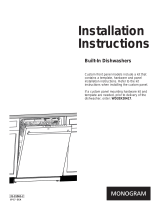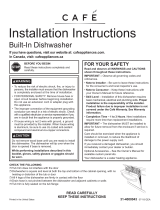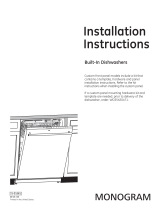
12
Dishwasher Installation
Printed in China
DISHWASHER WET TEST
• Turn on power supply or plug power cord into outlet,
if equipped.
• Select a cycle to run and push the Start button.
• Close dishwasher door. Dishwasher should start.
• Check to be sure that water enters the dishwasher.
If water does not enter the dishwasher, check to be
sure that water and power are turned on.
• Check for leaks under the dishwasher. If a leak is found,
turn off power at the breaker, and then tighten water
connections. Restore power after leak is corrected.
• Check for leaks around the door. A leak around
the door could be caused by door rubbing or
hitting against adjacent cabinets. Reposition the
dishwasher if necessary. See Step 11.
• Open dishwasher door. Press and hold the Start
pad, until the light next to the pad turns off, to cancel
the cycle. Close dishwasher door. The unit will begin
to drain. Check drain lines. If leaks are found, turn
off power at the breaker and correct plumbing as
necessary. Restore power after corrections are
made. See Steps 7 and 8.
• Open dishwasher door and make sure all of the
water has drained. If not, check that disposer plug
has been removed and/or air gap is not plugged.
Also check drain hose to be sure it is not kinked
underneath or behind dishwasher. See Step 8.
• Press Start button once again and run dishwasher through
another cycle. Check for leaks and correct if required.
• Repeat these steps as necessary.
STEP 18
CHECK THE FOLLOWING
• Dishwasher is square and level at both the top and
bottom of the cabinet opening, with no twisting or
distortion of the tub or door.
• All 4 legs of the dishwasher are firmly in contact with
the floor.
• Drain hose is not pinched between the dishwasher
and adjacent cabinets or walls.
STEP 17
REPLACE TOEKICK
• Install toekick insulation
(18” models only) by
placing ends of insulation
in left and right brackets.
Insulation should be
installed up under tub.
• Place the inner toekick
piece (with slots) against the
toekick bracket. The slots
should align with toekick.
Tip: Reduce sound from under the dishwasher.
Make sure toekick is against floor.
• Place larger toekick over the inner piece and install 4
toekick screws.
• Use both toekick pieces for all installation heights.
STEP 19
PRETEST CHECKLIST
Review this list after installing your dishwasher to
avoid charges for a service call that is not covered
by your Warranty.
• Check to be sure power is OFF.
• Open door and remove all foam and paper packaging.
• Locate the Owner’s Manual.
• Read the Owner’s Manual for operating instructions.
• Check door opening and closing. If door does not
open and close freely, check for proper spring
adjustments. If door drops or closes when released,
adjust spring tension. See Step 1.
• Check to be sure that wiring is secure under the
dishwasher, not pinched or in contact with door
springs or other components. See Step 13.
• Check door alignment with tub. If door hits tub, level
dishwasher. See Step 14.
• Check door alignment with cabinet. If door hits
cabinet, reposition dishwasher. See Step 11.
• Check that door spring does not contact water line,
fill hose, wiring or other components. See Steps 10
and 11.
• Verify water supply and drain lines are not kinked
or in contact with other components. Contact with
motor or dishwasher frame could cause noise. See
Steps 10 and 11.
• Turn on the sink hot water faucet and verify water
temperature. Incoming water temperature must be
between 120°F and 140°F. A minimum of 120°F
temperature is required for best wash performance.
See “PREPARE HOT WATER LINE”.
• Add 2 quarts of water to the bottom of the dishwasher
to lubricate the pump seal.
• Turn on water supply. Check for leaks. Tighten
connections if needed.
• Remove protective film if present from the control
panel and door.
• Avoid service call charges by ensuring there is an
air gap or drain hose routed through the required
32” minimum height. See Step 8.
STEP 16






















